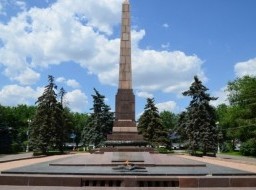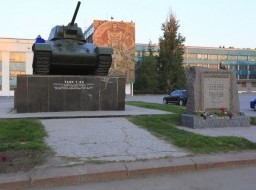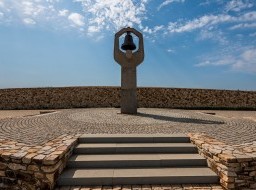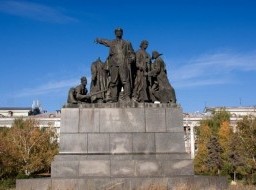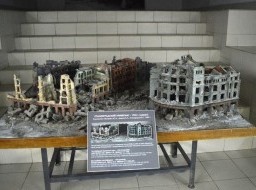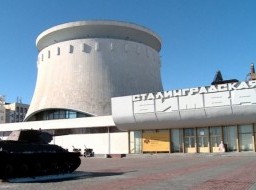The hall of military glory is a building in the form of a cylinder with a height of 13.5 m and a diameter of 42 m. It is open to visitors at any time of the day, there are no doors and windows - only holes in the walls. First of all visitors enter the gallery, in the depth of which there is a mosaic depicting the medal "For the Defense of Stalingrad" on the wall. Further, the so-called tunnel leads directly to the hall of the oval form. In its center, on the ceiling, there is a circular aperture from which, from a certain angle, the "Motherland" is visible, beneath it is a giant hand made of marble, holding a symbolic lit torch (this is the most popular place for photographs).
Round the clock in the Hall of Military Glory sounds the work of the famous German composer Robert Schumann "Dreams".
The Guard of Honor is on duty in the hall, changing every hour. And along the perimeter on the walls are the names of the defenders defending Stalingrad - about 7,5 thousand heroes, their names are carved on scarlet slabs bordered with mourning ribbons. After passing through the hall, you will go to the Square of Sorrow.
Right in the retaining wall is the entrance to the hall of Military Glory, made in the form of a rectangular portal. Inside there is a gallery, rising with short staircases to the darkness, only in the depth of the gallery on the closing end wall there is a mosaic of the medal "For the defense of Stalingrad". The gallery turns to the right and leads to the hall of Military Glory.
The Military Glory Hall is a cylindrical building with a diameter of 42 and a height of 13.5 meters. Directly under the ceiling along the entire perimeter is a slotted through hole. In the center of the ceiling is a round opening 11 meters in diameter, from which the Motherland is visible.
The Hall of Military Glory, or, as it is also called, the pantheon of Glory, is dedicated to the fallen defenders of Stalingrad. In place of the jubilation and triumph of victory comes the mood of sorrow, the sense of loss. Along the entire perimeter of the walls there are 34 lowered mourning banners made of red smalt and bordered with black ribbons. They are inscribed on the names of the Soviet soldiers who died in the Battle of Stalingrad - 7200 names in all. Above them, around the whole hall, in the form of a border that closes the wall, is an orange and black St. George ribbon, on which white words are laid out: "Yes, we were mere mortals, and few of us survived, but we all fulfilled our patriotic duty to a sacred Motherland! "
In the center of the room stands a white marble made from the ground, a hand clutching the torch of the Eternal Flame - the symbol of life that was handed to us by those who went to their deaths and laid down their lives in the Great Battle. On the torch it is inscribed: "Glory, glory, glory." Above the torch on the cut of the circular aperture in the center of the ceiling is a mosaic image of a golden wreath intertwined with a red and green ribbon of the medal "For the Defense of Stalingrad."
Here, too, is music - Schumann's "Dreams" sounding here mourning.
In the hall of the Military Glory, soldiers of the 46th separate shooting company of the honor guard of the Volgograd garrison are serving at the eternal fire and at the exit from the hall. It was established on January 28, 1968 and in 2008 marked the 40th anniversary. Volgograd Company of Honor Guard is considered one of the best in the Southern Federal District. The honor guard comes to the post at 9 am and carries the watch until 19-20 hours, depending on the time of the year. Change of guard is made every hour.
The double-meter double-meter ramp of white marble slowly rises along the walls, giving the opportunity to bypass the entire hall. He leads to the trapezoidal exit from the hall, located just above the entrance to the next square of the ensemble, called the Square of Sorrow.
According to the original plan, the panorama "The Defeat of the German Fascist Forces at Stalingrad" was to be located on the site of the Military Glory Hall, for which a box of the building was already built. But by this time Vuchetich decided that the panorama should be placed separately. And in the already ready construction it was decided to place the Hall of Military glory.

